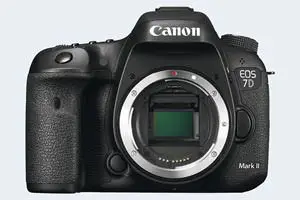Canon 7D II vs SL1
The Canon EOS 7D Mark II and the Canon EOS Rebel SL1 (labelled Canon 100D in some countries) are two digital cameras that were officially introduced, respectively, in September 2014 and March 2013. Both are DSLR (Digital Single Lens Reflex) cameras that are equipped with an APS-C sensor. The 7D Mark II has a resolution of 20 megapixels, whereas the SL1 provides 17.9 MP.
Below is an overview of the main specs of the two cameras as a starting point for the comparison.

Check 7D Mark II offers at
ebay.com

Check SL1 offers at
ebay.com
Going beyond this snapshot of core features and characteristics, what are the differences between the Canon EOS 7D Mark II and the Canon EOS Rebel SL1? Which one should you buy? Read on to find out how these two cameras compare with respect to their body size, their imaging sensors, their shooting features, their input-output connections, and their reception by expert reviewers.
Body comparison
The side-by-side display below illustrates the physical size and weight of the Canon 7D II and the Canon SL1. The two cameras are presented according to their relative size. Three consecutive perspectives from the front, the top, and the back are available. All width, height and depth measures are rounded to the nearest millimeter.
The SL1 can be obtained in two different colors (black, white), while the 7D Mark II is only available in black.
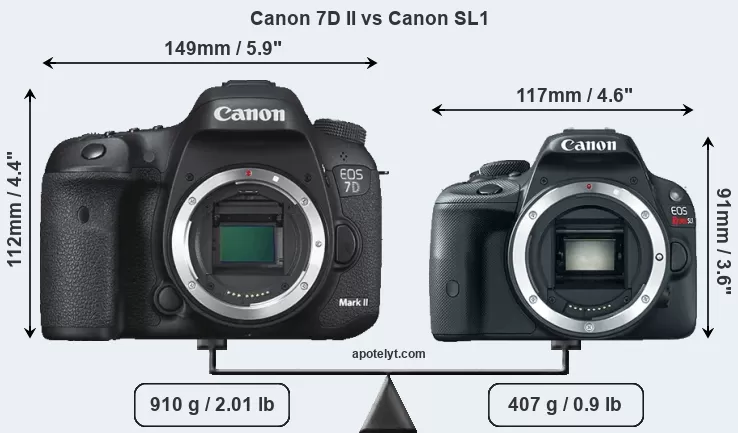
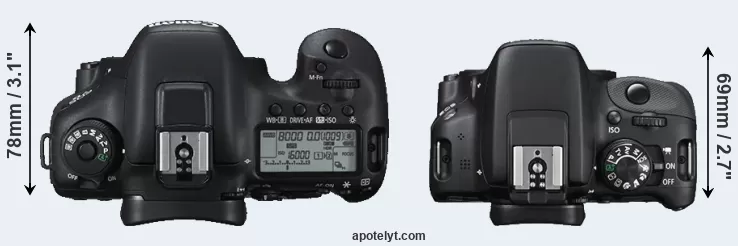
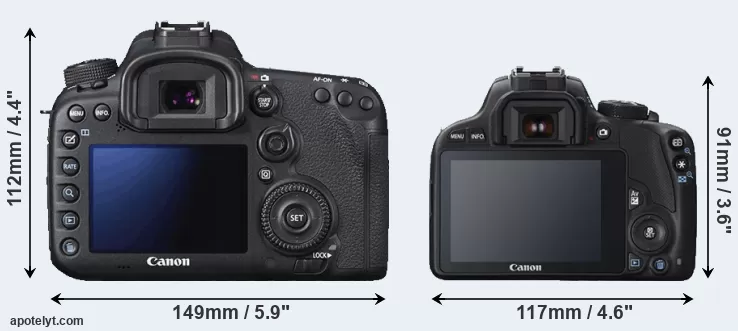
If the front view area (width x height) of the cameras is taken as an aggregate measure of their size, the Canon SL1 is considerably smaller (36 percent) than the Canon 7D II. Moreover, the SL1 is substantially lighter (55 percent) than the 7D Mark II. It is worth mentioning in this context that the 7D Mark II is splash and dust resistant, while the SL1 does not feature any corresponding weather-sealing.
The above size and weight comparisons are to some extent incomplete since they do not consider the interchangeable lenses that both of these cameras require. In this particular case, both cameras feature the same lens mount, so that they can use the same lenses. You can compare the optics available in the Canon EF Lens Catalog.
Concerning battery life, the 7D Mark II gets 670 shots out of its Canon LP-E6N battery, while the SL1 can take 380 images on a single charge of its Canon LP-E12 power pack.
The adjacent table lists the principal physical characteristics of the two cameras alongside a wider set of alternatives. If you want to switch the focus of the display and review another camera pair, you can move across to the CAM-parator tool and choose from the broad selection of possible camera comparisons there.

| Camera Model |
Camera Width |
Camera Height |
Camera Depth |
Camera Weight |
Battery Life |
Weather Sealing |
Camera Launch |
Launch Price |
Street Price |
||
|---|---|---|---|---|---|---|---|---|---|---|---|
| 1. | Canon 7D II | 149 mm | 112 mm | 78 mm | 910 g | 670 | Y | Sep 2014 | US$ 1 799 | ebay.com | |
| 2. | Canon SL1 | 117 mm | 91 mm | 69 mm | 407 g | 380 | n | Mar 2013 | US$ 549 | ebay.com | |
| 3. | Canon 6D | 145 mm | 111 mm | 71 mm | 770 g | 1090 | Y | Sep 2012 | US$ 2 099 | ebay.com | |
| 4. | Canon 7D | 148 mm | 111 mm | 74 mm | 860 g | 800 | Y | Sep 2009 | US$ 1 699 | ebay.com | |
| 5. | Canon 20D | 144 mm | 106 mm | 72 mm | 770 g | 700 | n | Aug 2004 | US$ 1 499 | ebay.com | |
| 6. | Canon 50D | 146 mm | 108 mm | 74 mm | 822 g | 800 | Y | Aug 2008 | US$ 1 299 | ebay.com | |
| 7. | Canon 60D | 145 mm | 106 mm | 79 mm | 755 g | 1100 | Y | Aug 2010 | US$ 1 399 | ebay.com | |
| 8. | Canon 70D | 139 mm | 104 mm | 79 mm | 755 g | 920 | Y | Jul 2013 | US$ 1 199 | ebay.com | |
| 9. | Canon M | 109 mm | 66 mm | 32 mm | 298 g | 230 | n | Jul 2012 | US$ 599 | ebay.com | |
| 10. | Canon SL2 | 122 mm | 93 mm | 70 mm | 453 g | 650 | n | Jun 2017 | US$ 549 | ebay.com | |
| 11. | Canon T3i | 133 mm | 100 mm | 80 mm | 570 g | 440 | n | Feb 2011 | US$ 599 | ebay.com | |
| 12. | Canon T4i | 133 mm | 100 mm | 79 mm | 575 g | 440 | n | Jun 2012 | US$ 849 | ebay.com | |
| 13. | Canon T5 | 130 mm | 100 mm | 78 mm | 480 g | 500 | n | Feb 2014 | US$ 449 | ebay.com | |
| 14. | Canon T5i | 133 mm | 100 mm | 79 mm | 580 g | 440 | n | Mar 2013 | US$ 649 | ebay.com | |
| 15. | Canon T6i | 132 mm | 101 mm | 78 mm | 555 g | 440 | n | Feb 2015 | US$ 749 | ebay.com | |
| Note: Measurements and pricing do not include easily detachable parts, such as add-on or interchangeable lenses or optional viewfinders. | |||||||||||
The price is, of course, an important factor in any camera decision. The listed launch prices provide an indication of the market segment that the manufacturer of the cameras have been targeting. The SL1 was launched at a markedly lower price (by 69 percent) than the 7D Mark II, which puts it into a different market segment. Usually, retail prices stay at first close to the launch price, but after several months, discounts become available. Later in the product cycle and, in particular, when the replacement model is about to appear, further discounting and stock clearance sales often push the camera price considerably down. Then, after the new model is out, very good deals can frequently be found on the pre-owned market.
Sensor comparison
The imaging sensor is at the core of digital cameras and its size is one of the main determining factors of image quality. A large sensor will generally have larger individual pixels that offer better low-light sensitivity, provide wider dynamic range, and have richer color-depth than smaller pixels in a sensor of the same technological generation. Moreover, a large sensor camera will give the photographer more control over depth-of-field in the image and, thus, the ability to better isolate a subject from the background. On the downside, larger sensors tend to be more expensive and lead to bigger and heavier cameras and lenses.
Both cameras under consideration feature an APS-C sensor, but their sensors differ slightly in size. The sensor area in the SL1 is 1 percent smaller. They nevertheless have the same format factor of 1.6. Both cameras have a native aspect ratio (sensor width to sensor height) of 3:2.
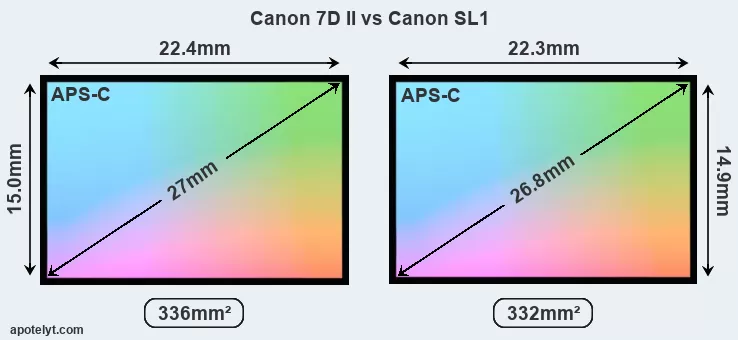
With 20MP, the 7D Mark II offers a higher resolution than the SL1 (17.9MP), but the 7D Mark II has smaller individual pixels (pixel pitch of 4.10μm versus 4.31μm for the SL1). However, the 7D Mark II is a somewhat more recent model (by 1 year and 5 months) than the SL1, and its sensor might have benefitted from technological advances during this time that enhance the light gathering capacity of its pixels.
The resolution advantage of the Canon 7D II implies greater flexibility for cropping images or the possibility to print larger pictures. The maximum print size of the 7D Mark II for good quality output (200 dots per inch) amounts to 27.4 x 18.2 inches or 69.5 x 46.3 cm, for very good quality (250 dpi) 21.9 x 14.6 inches or 55.6 x 37.1 cm, and for excellent quality (300 dpi) 18.2 x 12.2 inches or 46.3 x 30.9 cm. The corresponding values for the Canon SL1 are 25.9 x 17.3 inches or 65.8 x 43.9 cm for good quality, 20.7 x 13.8 inches or 52.7 x 35.1 cm for very good quality, and 17.3 x 11.5 inches or 43.9 x 29.3 cm for excellent quality prints.
The Canon EOS 7D Mark II has a native sensitivity range from ISO 100 to ISO 16000, which can be extended to ISO 100-51200. The corresponding ISO settings for the Canon EOS Rebel SL1 are ISO 100 to ISO 12800, with the possibility to increase the ISO range to 100-25600.
Technology-wise, both cameras are equipped with CMOS (Complementary Metal–Oxide–Semiconductor) sensors. Both cameras use a Bayer filter for capturing RGB colors on a square grid of photosensors. This arrangement is found in most digital cameras.
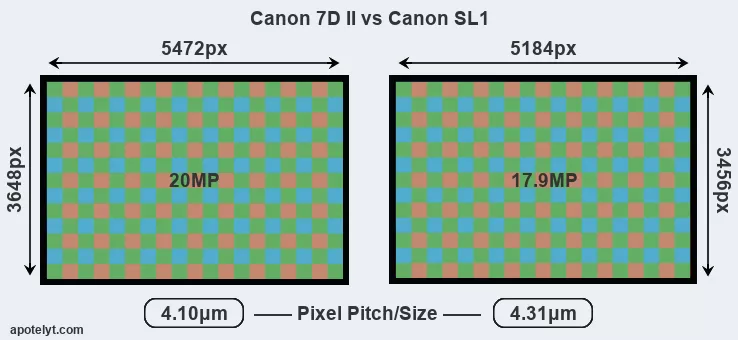
Since 2007, DXO Mark has published sensor performance measurements that have been derived using a consistent methodology. This service determines an overall sensor rating, as well as sub-scores for low-light sensitivity ("DXO Sports"), dynamic range ("DXO Landscape"), and color depth ("DXO Portrait"). Of the two cameras under review, the 7D Mark II has a notably higher overall DXO score than the SL1 (overall score 7 points higher), which gives it an advantage in terms of imaging quality. This advantage is based on 0.6 bits higher color depth, 0.5 EV in additional dynamic range, and 0.4 stops in additional low light sensitivity. The following table provides an overview of the physical sensor characteristics, as well as the sensor quality measurements for a selection of comparators.

| Camera Model |
Sensor Class |
Resolution (MP) |
Horiz. Pixels |
Vert. Pixels |
Video Format |
DXO Portrait |
DXO Landscape |
DXO Sports |
DXO Overall |
||
|---|---|---|---|---|---|---|---|---|---|---|---|
| 1. | Canon 7D II | APS-C | 20.0 | 5472 | 3648 | 1080/60p | 22.4 | 11.8 | 1082 | 70 | |
| 2. | Canon SL1 | APS-C | 17.9 | 5184 | 3456 | 1080/30p | 21.8 | 11.3 | 843 | 63 | |
| 3. | Canon 6D | Full Frame | 20.0 | 5472 | 3648 | 1080/30p | 23.8 | 12.1 | 2340 | 82 | |
| 4. | Canon 7D | APS-C | 17.9 | 5184 | 3456 | 1080/30p | 22.0 | 11.7 | 854 | 66 | |
| 5. | Canon 20D | APS-C | 8.2 | 3504 | 2336 | none | 21.9 | 11.0 | 721 | 62 | |
| 6. | Canon 50D | APS-C | 15.1 | 4752 | 3168 | none | 21.8 | 11.4 | 696 | 63 | |
| 7. | Canon 60D | APS-C | 17.9 | 5184 | 3456 | 1080/30p | 22.2 | 11.5 | 813 | 66 | |
| 8. | Canon 70D | APS-C | 20.0 | 5472 | 3648 | 1080/30p | 22.5 | 11.6 | 926 | 68 | |
| 9. | Canon M | APS-C | 17.9 | 5184 | 3456 | 1080/30p | 22.1 | 11.2 | 827 | 65 | |
| 10. | Canon SL2 | APS-C | 24.0 | 6000 | 4000 | 1080/60p | 23.6 | 13.4 | 1041 | 79 | |
| 11. | Canon T3i | APS-C | 17.9 | 5184 | 3456 | 1080/30p | 22.1 | 11.5 | 793 | 65 | |
| 12. | Canon T4i | APS-C | 17.9 | 5184 | 3456 | 1080/30p | 21.7 | 11.2 | 722 | 62 | |
| 13. | Canon T5 | APS-C | 17.9 | 5184 | 3456 | 1080/30p | 21.9 | 11.3 | 724 | 63 | |
| 14. | Canon T5i | APS-C | 17.9 | 5184 | 3456 | 1080/30p | 21.7 | 11.2 | 681 | 61 | |
| 15. | Canon T6i | APS-C | 24.0 | 6000 | 4000 | 1080/30p | 22.7 | 12.0 | 919 | 71 |
Many modern cameras are not only capable of taking still images, but also of capturing video footage. Both cameras under consideration have a sensor with sufficiently fast read-out times for moving pictures, but the 7D Mark II provides a higher frame rate than the SL1. It can shoot video footage at 1080/60p, while the SL1 is limited to 1080/30p.
Feature comparison
Apart from body and sensor, cameras can and do differ across a variety of features. The 7D Mark II and the SL1 are similar in the sense that both have an optical viewfinder. The latter is useful for getting a clear image for framing even in brightly lit environments. The viewfinder in the 7D Mark II offers a wider field of view (100%) than the one in the SL1 (95%), so that a larger proportion of the captured image is visible in the finder. In addition, the viewfinder of the 7D Mark II has a higher magnification (0.63x vs 0.54x), so that the size of the image transmitted appears closer to the size seen with the naked human eye. The table below summarizes some of the other core capabilities of the Canon 7D II and Canon SL1 in connection with corresponding information for a sample of similar cameras.

| Camera Model |
Viewfinder (Type or 000 dots) |
Control Panel (yes/no) |
LCD Specifications (inch/000 dots) |
LCD Attach- ment |
Touch Screen (yes/no) |
Max Shutter Speed * |
Max Shutter Flaps * |
Built-in Flash (yes/no) |
Built-in Image Stab |
||
|---|---|---|---|---|---|---|---|---|---|---|---|
| 1. | Canon 7D II | optical | Y | 3.0 / 1040 | fixed | n | 1/8000s | 10.0/s | Y | n | |
| 2. | Canon SL1 | optical | n | 3.0 / 1040 | fixed | Y | 1/4000s | 4.9/s | Y | n | |
| 3. | Canon 6D | optical | Y | 3.0 / 1040 | fixed | n | 1/4000s | 4.5/s | n | n | |
| 4. | Canon 7D | optical | Y | 3.0 / 920 | fixed | n | 1/8000s | 8.0/s | Y | n | |
| 5. | Canon 20D | optical | Y | 1.8 / 118 | fixed | n | 1/8000s | 5.0/s | Y | n | |
| 6. | Canon 50D | optical | Y | 3.0 / 920 | fixed | n | 1/8000s | 6.3/s | Y | n | |
| 7. | Canon 60D | optical | Y | 3.0 / 1040 | swivel | n | 1/8000s | 5.3/s | Y | n | |
| 8. | Canon 70D | optical | Y | 3.0 / 1040 | swivel | Y | 1/8000s | 7.0/s | Y | n | |
| 9. | Canon M | none | n | 3.0 / 1040 | fixed | Y | 1/4000s | 4.3/s | n | n | |
| 10. | Canon SL2 | optical | n | 3.0 / 1040 | swivel | Y | 1/4000s | 5.0/s | Y | n | |
| 11. | Canon T3i | optical | n | 3.0 / 1040 | swivel | n | 1/4000s | 3.7/s | Y | n | |
| 12. | Canon T4i | optical | n | 3.0 / 1040 | swivel | Y | 1/4000s | 5.0/s | Y | n | |
| 13. | Canon T5 | optical | n | 3.0 / 460 | fixed | n | 1/4000s | 3.0/s | Y | n | |
| 14. | Canon T5i | optical | n | 3.0 / 1040 | swivel | Y | 1/4000s | 5.0/s | Y | n | |
| 15. | Canon T6i | optical | n | 3.0 / 1040 | swivel | Y | 1/4000s | 5.0/s | Y | n | |
| Note: *) Information refers to the mechanical shutter, unless the camera only has an electronic one. | |||||||||||
One feature that is present on the 7D Mark II, but is missing on the SL1 is a top-level LCD. While being, of course, smaller than the rear screen, the control panel conveys some of the essential shooting information and can be convenient for quick and easy settings verification.
The Canon 7D II has an intervalometer built-in. This enables the photographer to capture time lapse sequences, such as flower blooming, a sunset or moon rise, without purchasing an external camera trigger and related software.
The 7D Mark II writes its imaging data to Compact Flash or SDXC cards, while the SL1 uses SDXC cards. The 7D Mark II features dual card slots, which can be very useful in case a memory card fails. In contrast, the SL1 only has one slot. Both cameras can use UHS-I cards, which provide for Ultra High Speed data transfer of up to 104 MB/s.
Connectivity comparison
For some imaging applications, the extent to which a camera can communicate with its environment can be an important aspect in the camera decision process. The table below provides an overview of the connectivity of the Canon EOS 7D Mark II and Canon EOS Rebel SL1 and, in particular, the interfaces the cameras (and selected comparators) provide for accessory control and data transfer.

| Camera Model |
Hotshoe Port |
Internal Mic / Speaker |
Microphone Port |
Headphone Port |
HDMI Port |
USB Port |
WiFi Support |
NFC Support |
Bluetooth Support |
||
|---|---|---|---|---|---|---|---|---|---|---|---|
| 1. | Canon 7D II | Y | stereo / mono | Y | Y | mini | 3.0 | - | - | - | |
| 2. | Canon SL1 | Y | mono / mono | Y | - | mini | 2.0 | - | - | - | |
| 3. | Canon 6D | Y | mono / mono | Y | - | mini | 2.0 | Y | - | - | |
| 4. | Canon 7D | Y | mono / - | Y | - | mini | 2.0 | - | - | - | |
| 5. | Canon 20D | Y | - / - | - | - | - | 1.1 | - | - | - | |
| 6. | Canon 50D | Y | - / - | - | - | mini | 2.0 | - | - | - | |
| 7. | Canon 60D | Y | mono / mono | Y | - | mini | 2.0 | - | - | - | |
| 8. | Canon 70D | Y | stereo / mono | Y | - | mini | 2.0 | Y | - | - | |
| 9. | Canon M | Y | stereo / mono | Y | - | mini | 2.0 | - | - | - | |
| 10. | Canon SL2 | Y | stereo / mono | Y | - | mini | 2.0 | Y | Y | Y | |
| 11. | Canon T3i | Y | mono / mono | Y | - | mini | 2.0 | - | - | - | |
| 12. | Canon T4i | Y | stereo / mono | Y | - | mini | 2.0 | - | - | - | |
| 13. | Canon T5 | Y | mono / mono | - | - | mini | 2.0 | - | - | - | |
| 14. | Canon T5i | Y | stereo / mono | Y | - | mini | 2.0 | - | - | - | |
| 15. | Canon T6i | Y | stereo / mono | Y | - | mini | 2.0 | Y | Y | - |
It is notable that the 7D Mark II has a headphone jack, which is not present on the SL1 This port makes it possible to attach external headphones and monitor the quality of sound during the recording process.
Studio photographers will appreciate that the Canon 7D II (unlike the SL1) features a PC Sync socket, so that professional strobe lights can be controlled by the camera.
Travel and landscape photographers will find it useful that the 7D Mark II has an internal geolocalization sensor and can record GPS coordinates in its EXIF data.
Both the 7D Mark II and the SL1 have been discontinued, but can regularly be found used on ebay. The SL1 was replaced by the Canon SL2, while the 7D Mark II does not have a direct successor. Further information on the features and operation of the 7D Mark II and SL1 can be found, respectively, in the Canon 7D II Manual (free pdf) or the online Canon SL1 Manual.
Review summary
So what conclusions can be drawn? Is the Canon 7D II better than the Canon SL1 or vice versa? A synthesis of the relative strong points of each of the models is listed below.
Reasons to prefer the Canon EOS 7D Mark II:
- More detail: Offers more megapixels (20 vs 17.9MP) with a 6% higher linear resolution.
- Better image quality: Scores markedly higher (7 points) in the DXO overall assessment.
- Better low-light sensitivity: Requires less light for good images (0.4 stops ISO advantage).
- Better video: Provides higher movie framerates (1080/60p versus 1080/30p).
- Better sound control: Has a headphone port that enables audio monitoring while recording.
- More complete view: Has a viewfinder with a larger field of view (100% vs 95%).
- Larger viewfinder image: Features a viewfinder with a higher magnification (0.63x vs 0.54x).
- Easier setting verification: Features an LCD display on top to control shooting parameters.
- Faster shutter: Has higher mechanical shutter speed (1/8000s vs 1/4000s) to freeze action.
- Faster burst: Shoots at higher frequency (10 vs 4.9 flaps/sec) to capture the decisive moment.
- Easier time-lapse photography: Has an intervalometer built-in for low frequency shooting.
- Longer lasting: Can take more shots (670 versus 380) on a single battery charge.
- Better sealing: Is weather sealed to enable shooting in dusty or wet environments.
- Easier geotagging: Features an internal GPS sensor to log localization data.
- Faster data transfer: Supports a more advanced USB protocol (3.0 vs 2.0).
- Better studio light control: Has a PC Sync socket to connect to professional strobe lights.
- Greater peace of mind: Features a second card slot as a backup in case of memory card failure.
- More modern: Is somewhat more recent (announced 1 year and 5 months after the SL1).
Advantages of the Canon EOS Rebel SL1:
- Fewer buttons to press: Has a touchscreen to facilitate handling and shooting adjustments.
- More compact: Is smaller (117x91mm vs 149x112mm) and will fit more readily into a bag.
- Less heavy: Has a lower weight (by 503g or 55 percent) and is thus easier to take along.
- More affordable: Was introduced into a lower priced category (69 percent cheaper at launch).
- More heavily discounted: Has been on the market for longer (launched in March 2013).
If the count of relative strengths (bullet points above) is taken as a measure, the 7D Mark II is the clear winner of the match-up (18 : 5 points). However, the relevance of individual strengths will vary across photographers, so that you might want to apply your own weighing scheme to the summary points when reflecting and deciding on a new camera. A professional sports photographer will view the differences between cameras in a way that diverges from the perspective of a street photog, and a person interested in family portraits has distinct needs from a landscape shooter. Hence, the decision which camera is best and worth buying is often a very personal one.
How about other alternatives? Do the specifications of the Canon 7D II and the Canon SL1 place the cameras among the top in their class? Find out in the latest Best DSLR Camera listing whether the two cameras rank among the cream of the crop.
In any case, while the specs-based evaluation of cameras can be instructive in revealing their potential as photographic tools, it says little about, for example, the shooting experience and imaging performance of the 7D Mark II and the SL1 in practical situations. User reviews, such as those found at amazon, can sometimes inform about these issues, but such feedback is often incomplete, inconsistent, and biased.
Expert reviews
This is why expert reviews are important. The following table reports the overall ratings of the cameras as published by some of the major camera review sites (amateurphotographer [AP], cameralabs [CL], digitalcameraworld [DCW], dpreview [DPR], ephotozine [EPZ], photographyblog [PB]). As can be seen, the professional reviewers agree in many cases on the quality of different cameras, but sometimes their assessments diverge, reinforcing the earlier point that a camera decision is often a very personal choice.

| Camera Model |
AP score |
CL score |
DCW score |
DPR score |
EPZ score |
PB score |
Camera Launch |
Launch Price |
Street Price |
||
|---|---|---|---|---|---|---|---|---|---|---|---|
| 1. | Canon 7D II | 4.5/5 | + | 3.5/5 | 84/100 | 4/5 | 4.5/5 | Sep 2014 | US$ 1 799 | ebay.com | |
| 2. | Canon SL1 | 4/5 | + | .. | 78/100 | 4/5 | 4/5 | Mar 2013 | US$ 549 | ebay.com | |
| 3. | Canon 6D | 5/5 | + + | .. | 83/100 | 4.5/5 | 4.5/5 | Sep 2012 | US$ 2 099 | ebay.com | |
| 4. | Canon 7D | 5/5 | + + | .. | 84/100 | 4.5/5 | 4.5/5 | Sep 2009 | US$ 1 699 | ebay.com | |
| 5. | Canon 20D | .. | .. | .. | + + | .. | .. | Aug 2004 | US$ 1 499 | ebay.com | |
| 6. | Canon 50D | .. | + + | .. | + + | 4.5/5 | 4.5/5 | Aug 2008 | US$ 1 299 | ebay.com | |
| 7. | Canon 60D | 5/5 | + | .. | 79/100 | 4/5 | 4.5/5 | Aug 2010 | US$ 1 399 | ebay.com | |
| 8. | Canon 70D | 5/5 | + + | .. | 83/100 | 4.5/5 | 5/5 | Jul 2013 | US$ 1 199 | ebay.com | |
| 9. | Canon M | 3/5 | + | .. | .. | 4/5 | 4/5 | Jul 2012 | US$ 599 | ebay.com | |
| 10. | Canon SL2 | 4/5 | + + | 4/5 | 78/100 | 4.5/5 | 4.5/5 | Jun 2017 | US$ 549 | ebay.com | |
| 11. | Canon T3i | 3/5 | o | .. | 77/100 | 4.5/5 | 4.5/5 | Feb 2011 | US$ 599 | ebay.com | |
| 12. | Canon T4i | 4/5 | + + | .. | 77/100 | 4.5/5 | 4.5/5 | Jun 2012 | US$ 849 | ebay.com | |
| 13. | Canon T5 | 3/5 | + | .. | .. | 4/5 | 4.5/5 | Feb 2014 | US$ 449 | ebay.com | |
| 14. | Canon T5i | .. | .. | .. | 76/100 | 4.5/5 | 4.5/5 | Mar 2013 | US$ 649 | ebay.com | |
| 15. | Canon T6i | 5/5 | .. | .. | 75/100 | 4.5/5 | 4.5/5 | Feb 2015 | US$ 749 | ebay.com | |
| Note: (+ +) highly recommended; (+) recommended; (o) reviewed; (..) not available. | |||||||||||
Care should be taken when interpreting the review scores above, though. The assessments were made in relation to similar cameras of the same technological generation. A score, therefore, has to be seen in close connection to the price and market introduction time of the camera, and rating-comparisons among cameras that span long time periods or concern very differently equipped models make little sense. Also, please note that some of the review sites have changed their methodology and reporting over time.

Check 7D Mark II offers at
ebay.com

Check SL1 offers at
ebay.com
Other camera comparisons
Did this review help to inform your camera decision process? In case you are interested in seeing how other cameras pair up, just make a corresponding selection in the search boxes below. There is also a set of direct links to comparison reviews that other users of the CAM-parator app explored.
- Canon 250D vs Canon 7D II
- Canon 6D vs Canon SL1
- Canon 7D II vs Fujifilm X-T3
- Canon 7D II vs Leica D-LUX 7
- Canon 7D II vs Nikon Z7 II
- Canon 7D II vs Panasonic GM5
- Canon 7D II vs Sony A7 IV
- Canon SL1 vs Panasonic GF1
- Canon SL1 vs Ricoh WG-6
- Canon SL1 vs Sony A7S II
- Canon SL1 vs Sony NEX-6
- Canon SL1 vs Sony RX1R II
Specifications: Canon 7D II vs Canon SL1
Below is a side-by-side comparison of the specs of the two cameras to facilitate a quick review of their differences and common features.
| Camera Model | Canon 7D II | Canon SL1 |
|---|---|---|
| Camera Type | Digital single lens reflex | Digital single lens reflex |
| Camera Lens | Canon EF mount lenses | Canon EF mount lenses |
| Launch Date | September 2014 | March 2013 |
| Launch Price | USD 1,799 | USD 549 |
| Sensor Specs | Canon 7D II | Canon SL1 |
| Sensor Technology | CMOS | CMOS |
| Sensor Format | APS-C Sensor | APS-C Sensor |
| Sensor Size | 22.4 x 15.0 mm | 22.3 x 14.9 mm |
| Sensor Area | 336 mm2 | 332.27 mm2 |
| Sensor Diagonal | 27 mm | 26.8 mm |
| Crop Factor | 1.6x | 1.6x |
| Sensor Resolution | 20 Megapixels | 17.9 Megapixels |
| Image Resolution | 5472 x 3648 pixels | 5184 x 3456 pixels |
| Pixel Pitch | 4.10 μm | 4.31 μm |
| Pixel Density | 5.94 MP/cm2 | 5.39 MP/cm2 |
| Moiré control | Anti-Alias filter | Anti-Alias filter |
| Movie Capability | 1080/60p Video | 1080/30p Video |
| ISO Setting | 100 - 16,000 ISO | 100 - 12,800 ISO |
| ISO Boost | 100 - 51,200 ISO | 100 - 25,600 ISO |
| Image Processor | DIGIC 6 (Dual) | DIGIC 5 |
| DXO Sensor Quality (score) | 70 | 63 |
| DXO Color Depth (bits) | 22.4 | 21.8 |
| DXO Dynamic Range (EV) | 11.8 | 11.3 |
| DXO Low Light (ISO) | 1082 | 843 |
| Screen Specs | Canon 7D II | Canon SL1 |
| Viewfinder Type | Optical viewfinder | Optical viewfinder |
| Viewfinder Field of View | 100% | 95% |
| Viewfinder Magnification | 0.63x | 0.54x |
| Top-Level Screen | Control Panel | no Top Display |
| LCD Framing | Live View | Live View |
| Rear LCD Size | 3.0inch | 3.0inch |
| LCD Resolution | 1040k dots | 1040k dots |
| LCD Attachment | Fixed screen | Fixed screen |
| Touch Input | no Touchscreen | Touchscreen |
| Shooting Specs | Canon 7D II | Canon SL1 |
| Focus System | Phase-detect AF | Phase-detect AF |
| Continuous Shooting | 10 shutter flaps/s | 4.9 shutter flaps/s |
| Shutter Life Expectancy | 200 000 actuations | 100 000 actuations |
| Time-Lapse Photography | Intervalometer built-in | no Intervalometer |
| Fill Flash | Built-in Flash | Built-in Flash |
| Storage Medium | CF or SDXC cards | SDXC cards |
| Single or Dual Card Slots | Dual card slots | Single card slot |
| UHS card support | UHS-I | UHS-I |
| Connectivity Specs | Canon 7D II | Canon SL1 |
| External Flash | Hotshoe | Hotshoe |
| Studio Flash | PC Sync socket | no PC Sync |
| USB Connector | USB 3.0 | USB 2.0 |
| HDMI Port | mini HDMI | mini HDMI |
| Microphone Port | External MIC port | External MIC port |
| Headphone Socket | Headphone port | no Headphone port |
| Wifi Support | no Wifi | no Wifi |
| Geotagging | GPS built-in | no internal GPS |
| Body Specs | Canon 7D II | Canon SL1 |
| Environmental Sealing | Weathersealed body | not weather sealed |
| Battery Type | Canon LP-E6N | Canon LP-E12 |
| Battery Life (CIPA) | 670 shots per charge | 380 shots per charge |
| Body Dimensions |
149 x 112 x 78 mm (5.9 x 4.4 x 3.1 in) |
117 x 91 x 69 mm (4.6 x 3.6 x 2.7 in) |
| Camera Weight | 910 g (32.1 oz) | 407 g (14.4 oz) |

Check 7D Mark II offers at
ebay.com

Check SL1 offers at
ebay.com
Did you notice an error on this page? If so, please get in touch, so that we can correct the information.
